Review of the septic tank for the “Tank” dacha: how it works, advantages and disadvantages of the system
A modern country house is as comfortable as a city apartment.It is equipped with a toilet, shower, washing machine and dishwasher. At the same time, centralized sewerage is most often absent. Its functions can be performed by a septic tank for a summer residence Tank, in which wastewater is accumulated and partially processed.
The treatment plant has gained popularity due to its simplicity of design, reliability and affordable cost. Are you unsure about your purchase? We invite you to familiarize yourself with the structure and operating principle of a septic tank, its pros and cons, as well as the rules for installation and maintenance.
The information presented will help you decide on the choice of modification of the Tank purifier and understand the feasibility of its installation. The material will also be useful to those who already use a storage septic tank at their dacha.
The content of the article:
- Construction of a septic tank "Tank"
- Operating principle of the installation
- Advantages and disadvantages of the Tank septic tank
- How to increase system efficiency?
- Which area is not suitable for such a septic tank?
- Installation and launch of a new installation
- Septic tank conservation rules
- Conclusions and useful video on the topic
Construction of a septic tank "Tank"
A septic tank is a treatment facility in which accumulation, sedimentation and partial biological purification of wastewater occurs. It consists of one to three sections connected in series, the last of which is divided into two chambers.
The second chamber contains a biofilter designed for anaerobic processing of wastewater, and a floating load that performs filtration at the outlet of the tank.
As a result of multi-stage purification in the process of overflow, treatment with bacteria and filtration, the purification degree reaches 78-80%. After leaving the treatment plant, the wastewater enters an infiltrator installed on the ground. Here, additional purification takes place up to 95 - 100% and the purified mass is discharged into the underlying layers of soil, filtration fields or sewers.

At dachas, devices presented in one housing are most often used.
The structure consists of the following elements:
- Housings, the volume of which is divided into two or three sections by partitions with overflows.
- Biofilter with polymer floating loading.
- Patrubkov - incoming and outgoing.
- One or two necks with tight-fitting lids.
The number of sections in a septic tank depends on its total volume. Two chambers have small-volume septic tanks capable of processing up to 600 liters of wastewater per day (version Tank-1). The rest are divided into three parts.
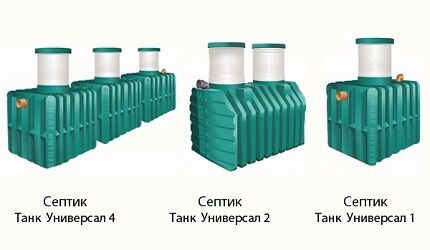
The productivity (daily volume of water disposal) of single-body septic tanks, depending on the modification, is enough to serve from one to six residents, which corresponds to water disposal within 1200 l/day.
If it is necessary to process a larger amount of wastewater, then separate modules serve as working chambers, each of which in this case performs its own function. This is how a septic tank is designed Tank-4 – it consists of three tanks connected by overflows.
In addition, by successively adding additional containers, you can increase the performance of the cleaning system with any version of the Tank septic tank to the required level.
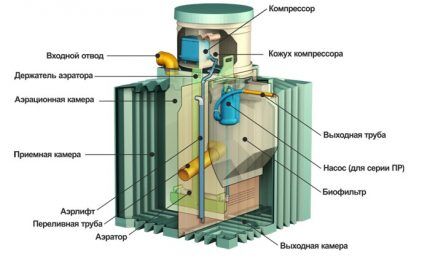
Features of the housing design
The body of the device is a monolithic cast container made of ribbed polyethylene, without any seams or joints. Thanks to its rectangular shape, the septic tank is compact and stable, so it is quite easy to install even for a non-professional.
In the upper part of the hull there are one (Tank-1) or two service hatches. The necks are attached to the sealant according to the male-female principle.
Ribbed walls, remaining elastic and resilient at any temperature, increase the rigidity and strength of the structure.If installed correctly, they can withstand soil pressure even during frost heaving.
The ribbed surface increases the adhesion of the tank to the surrounding dense sand-cement cushion, due to which it is firmly held in the ground and does not float up during spring floods. Therefore, the septic tank Tank does not require additional anchoring during installation.
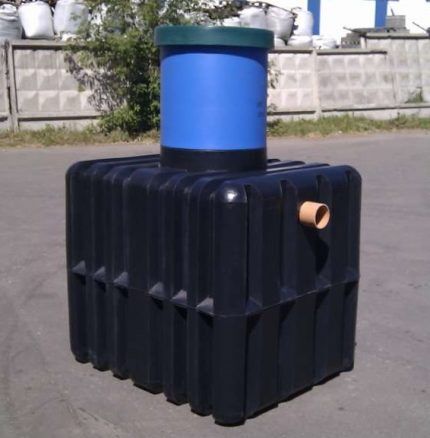
The material from which the tank is made is a durable polymer compound. It is completely safe from an environmental point of view, biologically pure material.
It does not decompose under the influence of microorganisms, does not react with chemicals, and is not subject to soil erosion and corrosion. The service life of a polypropylene tank is at least 50 years.
Biofilter design and functions
The biofilter in a septic tank is always installed in the last chamber. It is a container in which optimal conditions for growth and reproduction are created. bacterial colonies. To ensure the physical possibility of microorganisms settling, the filter is filled with floating bioload.
The main labor force of the biofilter is anaerobic bacteria, colonies of which settle on the walls and bottom of the tanks. Filtration beds are products whose shape allows, with minimal dimensions, to create a large area for mechanical cleaning.
The polymer elements of the floating load are lighter than water, so they float up and are located at the outlet pipe of the section with the biofilter.The manufacturing material is chemically stable and absolutely safe for any aquatic organisms.
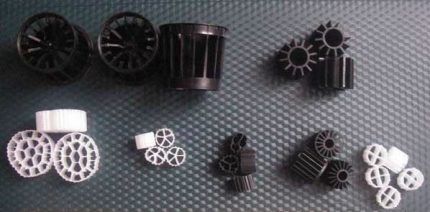
The free surface area is the main indicator of the performance of the biological load and determines the capacity of the entire treatment system.
In addition to processing by hydrobionts, centrifugal separation also occurs in the biofilter. The filter container itself is made in a form that allows it to work on the principle of a hydrocyclone.
The inlet holes are located in such a way that water enters at a certain angle (tangentially) and unwinds. Due to vortex microflows, all remaining heavy suspensions are eliminated.
Operating principle of the installation
Wastewater treatment in a septic tank Tank occurs only mechanically and biologically, without the use of any chemicals. If the structure includes three sections, then the process is accordingly divided into three stages.
Each stage takes place in its own working area:
- First section is adopted. All household waste flows into it through the sewer from the house and settles. Here fermentation and mechanical separation take place - layer-by-layer separation of liquid fractions of different weights. Heavy particles sink to the bottom, light particles (fat, feces, etc.) rise to the surface, and clarified water remains in the middle.
- Second section. Liquid from the middle layer of the primary container enters it through the overflow.Here it continues to ferment under the influence of microorganisms and settle - the movement occurs very slowly, without external disturbances. This promotes the settling of small inclusions that did not have time to precipitate in the previous settling tank.
- Third section - biofilter. In its lower part, centrifugal separation and purification from residual heavy impurities is carried out. Liquid that is contaminated only of a biological nature approaches the upper part of the filter. When passing through a bioload, where bacterial colonies are concentrated, organic matter is removed.
The solid sediment that has settled to the bottom, formed as a result of filtration, separation and the work of bacteria, must be periodically removed through the hose of the sewer machine.

Colonies of bacteria that live and multiply in the space of the biological load use organic matter dissolved in water as food. Therefore, recycling occurs naturally. The process produces harmless carbon dioxide, some volatile hydrocarbons and water.
To remove gases, ventilation is installed, which is a mandatory element of the cleaning system. Otherwise, volatile elements released during fermentation and biodegradation will accumulate in the container and be released through the sewer line into the home. An unpleasant odor will fill the building.
Septic tanks Tank are sealed containers in which the biological treatment of wastewater is carried out by anaerobic bacteria, without access to oxygen.These microorganisms are less effective than aerobic microorganisms (used in energy-dependent systems).
Therefore, the degree of purification of water from organic matter when leaving the septic tank reaches 75-80%. Draining such liquid into the ground is prohibited by sanitary standards.
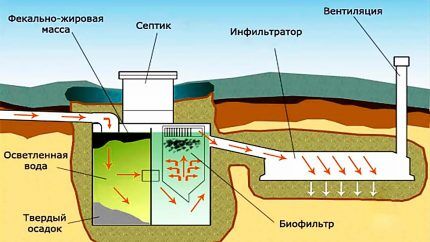
To further purify wastewater after the Tank septic tank, a ground filtration device must be used. These are structures in which water from a septic tank passes through a layer of crushed stone or gravel. All remaining contaminants settle in the filter mound.

Such devices are:
- infiltrators – industrially manufactured tanks without a bottom (resemble an inverted bathtub);
- filtration fields – drainage pipe system;
- filter well — an absorption tank without a bottom with a drainage layer.
The type of structure and installation scheme of the sewer system are selected depending on the type of soil on the site and the groundwater level. It is best to consult a specialist on this issue.
When installed correctly, the septic tank Tank works effectively both in dry weather and during spring floods and heavy rains. It is not afraid of frost heaving and seasonal soil shifts.
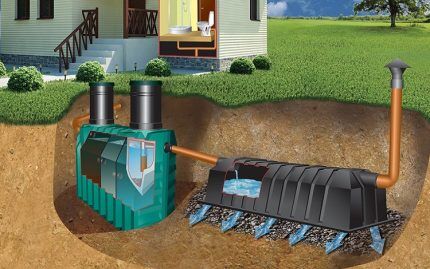
Advantages and disadvantages of the Tank septic tank
Non-volatile septic tanks "Tank" are optimally suited for autonomous sewerage devices in a private house. It is advisable to equip them in areas of country houses and country houses for seasonal or periodic residence, as well as in areas with frequent power outages.

Local communications that do not require electricity to operate are also used in the construction of energy-saving buildings. Technologies that allow resource conservation are becoming increasingly popular.
Advantages of these septic tanks:
- Simplicity and reliability of design — the tank is practically not subject to wear.
- Hull strength — the septic tank withstands the destructive influences of the environment and ensures reliable operation of the system.
- Ease of maintenance — absence of components requiring periodic maintenance or repair. All maintenance of the cleaning system based on the septic tank Tank consists of calling a vacuum cleaner once a year.
- Possibility of increased productivity by adding additional modules, which can be connected even to a functioning system.
- Cleaning efficiency. A sewer system combining a septic tank and an additional filtration device ensures complete purification of wastewater from contaminants - up to 98%.
- Durability — service life is at least 50 years.
- Ease of installation. The compact body of a convenient rectangular shape and the light weight of the structure allow you to install the septic tank on your own, without the involvement of specialists.
- Acceptable price - Compared to competitors, the cost of a septic tank is quite acceptable.
The septic tank is one of the most unpretentious in operation. Toilet paper, food debris and a reasonable amount of household cleaners and detergents are allowed into the system.
However, like any engineering structure, the septic tank Tank has not only advantages, but also disadvantages:
- The water leaving the septic tank cannot be drained into the ground due to sanitary standards - for its further purification, a crushed stone-sand or gravel-sand filter is used;
- Installation flaws lead to the appearance of an unpleasant odor in the house coming from the sewer;
- The sludge accumulated in the tank cannot be used as a fertilizer, since it may contain organic residues and harmful substances that can cause contamination of the soil and groundwater.
To prevent odors from appearing in the house, a ventilation riser must be built into the supply pipeline. Anaerobic bacteria produce methane when processing wastewater, so the gases must be removed. Also, when installing the tank, do not allow it to tilt.
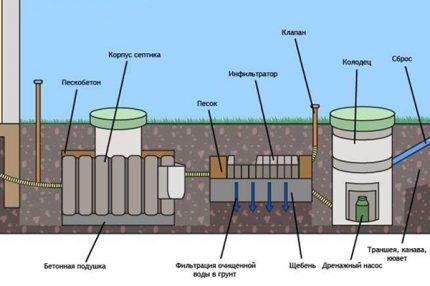
How to increase system efficiency?
Microorganisms are distributed throughout the entire volume of the septic tank and are concentrated in the bioload. They enter the system along with wastewater, and, if there is a sufficient amount of organic matter, they successfully grow, multiply and eat organic components.
Thanks to bacteria, constant fermentation occurs in the septic tank.Due to this, organic matter, mineral suspensions and fat fractions are separated - the liquid is stratified.
The efficiency of wastewater treatment depends on the size of the microorganism population. The market offers a large selection of ready-made preparations containing colonies of bacteria - bioactivators. Popular drug - "Doctor Robik".
By periodically adding them to the system, home owners improve the quality of cleaning. This is also an effective prevention against problems that arise when the bacterial population decreases - unpleasant odor, the formation of thick deposits on the walls, hardening of sludge.
The activity of anaerobes contributes to the liquefaction of bottom silt and dense crust on the surface, due to which the sewer service can be called much less frequently - once every three years.
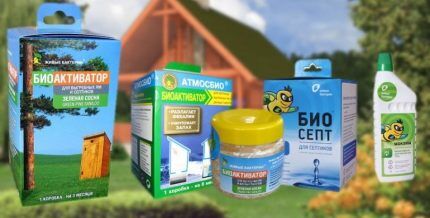
When is the use of a bioactivator necessary?
For the normal functioning of bacteria, it is necessary that organic matter and a sufficient amount of liquid enter the system. Accordingly, for a constantly functioning septic tank, the use of industrial biological preparations is not necessary.
However, violations in operation lead to the death of colonies, as evidenced by the appearance of an unpleasant odor. In this case, the bioactivator should be added first. Most often, such a measure is sufficient to restore normal operation of the cleaning system.
In the following cases, you should not wait for the smell to appear, since in any case they help reduce the population of microorganisms.
It is better to immediately add a ready-made biological product, which is administered:
- After a long period of inactivity – for example, at the beginning of the summer season. If conservation was carried out properly, the bacteria in the septic tank do not die. However, their number is significantly reduced. The bioactivator helps to establish the functioning of the system in a much shorter time than would occur under natural conditions.
- After dumping chemicals into the sewer and disinfectants that contribute to the death of aquatic organisms.
- After liquid freezes in a septic tank. This can happen if the tank is installed without an insulating layer.
Sewage odors also occur when a thick layer of fatty deposits has accumulated on the drain pipes and walls. Artificially added colonies of bacteria break down and liquefy sediments, after which they freely flow into the sump.
How to apply a bioactivator?
A couple of buckets (about 20 liters) of water are poured into the sewer. In order for the biomaterial to get into the septic tank, it is poured or poured into the toilet. After this, the water is drained two or three times.

Before use, liquid preparations are simply shaken, but products in tablets or granules should be applied in accordance with the attached instructions. Some manufacturers recommend dissolving the biomaterial in water, others recommend adding it dry.
After adding the bacterial preparation, monitor the water level in the septic tank for two to three days, adding it as needed.
Why is additional filtration needed?
Anaerobes are not able to completely process organic compounds. They decompose complex compounds into simpler ones, which are contained in the liquid leaving the septic tank.
By pouring such water into the ground, you can become the culprit of contamination of it and groundwater. To completely break down simple organic matter, plums are exposed to aerobic bacteria.
When installing natural additional filtration, water from the septic tank passes through a layer of crushed stone or gravel, which is well saturated with oxygen. Aerobic microorganisms settle in such a filtration layer, the colonies of which grow and multiply when nutrient organic matter enters.
In this way, the last stage of complete wastewater treatment in the sewer system is carried out based on the Tank septic tank.
Which area is not suitable for such a septic tank?
The septic tank itself is absolutely not demanding on the soil. The case is durable and sealed, the material is not subject to any impact. The design ensures reliable operation, even if the housing is constantly in the water.
The presence of a sand-cement cushion around the container protects against uneven squeezing out of soil layers during frost heaving.
But there are other mandatory elements in the cleaning system. Since the additional filtration device requires good absorption of water into the ground, a high groundwater level can become an obstacle to the installation of such a septic tank. According to building regulations, there must be at least a meter between the filter bottom and the roof of the water-saturated layer.
Options for septic tanks that are suitable for areas with high groundwater are described in Here.
The second good reason is poorly absorbent clay soils, which do not allow treated wastewater to pass into or below them.In such situations, the filtration layer is in the water and does not fulfill its task: it does not free the system from the purified liquid component.
However, it is possible to use a non-volatile system in such areas. You just need to choose the right installation scheme.
For the installation of sewerage systems where groundwater is close to each other, infiltrators are used for additional purification, which are installed above the critical level. A storage well with drain pump.
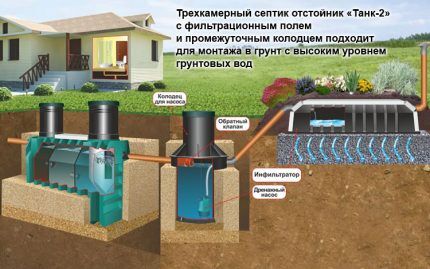
If the site has clay soil, then it is used for post-treatment of wastewater. filtration fields. A drainage system is installed under the main filter layer; water accumulates in a well with a pump and is discharged to the surface into a drainage ditch.
Installation and launch of a new installation
Before starting, the septic tank should be approximately 60-70% filled with water. Filling is carried out at the installation stage. Then, over the course of about two weeks, the clean water is gradually replaced by wastewater. After a sufficient amount of organic substances has accumulated in the tank, bioactivators are introduced into the sewer.
You shouldn’t wait for the drains to naturally fill with microflora. This takes up to several months, and during this time the quality of water purification will be low, an unpleasant odor and various kinds of problems may appear. For example, the accumulation of deposits in pipes and on the walls of the tank, which should not be allowed.
Therefore, it is necessary to establish the operation of the cleaning system as quickly as possible, which is where ready-made strains of bacteria help. Before purchasing, you should make sure that the bioactivator is intended for anaerobic septic tanks. Loading aerobes will result in a long startup time.
If you are interested in the features of installing a “Tank” septic tank, then we have separate article - We recommend that you read it.
Septic tank conservation rules
If the cleaning system works year-round, then there will be no problems, even if the owners leave the house for a couple of weeks. But if you plan to stop the flow of wastewater into the septic tank for more than a month, then it is necessary to provide the bacteria with food. To do this, fermented milk fertilizer is introduced into the sewer.
Question preserving the septic tank for the winter due attention should be paid, since the tank contains living microflora that must be preserved. To do this, it is necessary to ensure sufficient insulation of the structure.
The insulation must be placed on the body when installing a septic tank. If there is no insulation, you can do it before the onset of cold weather.
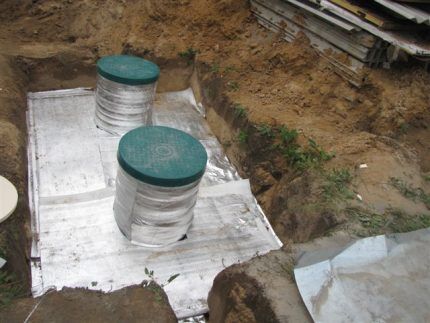
Do not do it:
- Pump out drains and flush chambers, otherwise the bacterial population will have to be restored in the new season.
- Leave the tank empty - this guarantees its squeezing out of the frozen ground and floating up during spring floods.
For the winter, the septic tank is left about 2/3 full. This amount of liquid compensates for soil pressure, and the empty space ensures that the septic tank will not burst even if the contents freeze completely.
If wells with submersible pumps are installed in the cleaning system, then the units are suspended above the water level for the winter season.
Conclusions and useful video on the topic
A comic video from the manufacturer clearly shows the main components of a cleaning system with a Tank septic tank:
Some stages of production of septic tanks Tank. Visual measurements of the thickness of the body walls in a section:
Septic Tank is popular in the Russian Federation and many CIS countries. It has a simple and universal design. A block-modular cleaning system can effectively serve a small country house, a spacious cottage, or several buildings at once.
If you have experience installing and operating a septic tank Tank, please share the information with our readers. Leave comments on the article and ask questions on the topic - the contact form is located below.
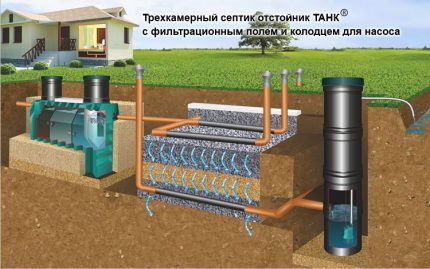




Good afternoon What are the requirements for the distance from the septic tank to the foundation of the house, to the trees, to the fence?
Good afternoon, Olga. As such, there are no strict requirements for the installation distance to the septic tank. Here are the main points:
1. SNiP recommends installing a septic tank at a distance of at least three meters from the foundation.
2. Different types of trees have different root systems. Damage to the core septic tank is unlikely, but the fibrous system is quite capable. The safe distance is determined by the fact. Can range from 2 to 4 meters.
3. It is recommended to install a septic tank along the border of the site on the side of the roadway at a distance of at least 5 meters from the road - in the future this will facilitate maintenance and troubleshooting.The distance to the neighbor's fence is at least 3 meters.
Hello, how much floating bio-loading is placed in septic tank tank 3?